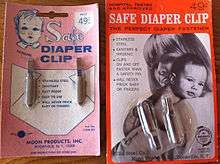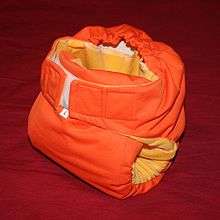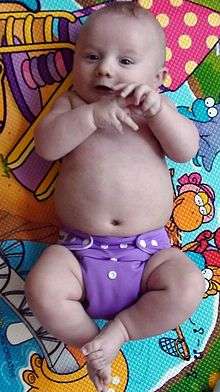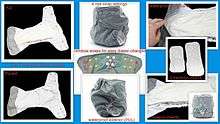Cloth diaper




A cloth diaper is a reusable diaper made from natural fibers, man-made materials, or a combination of both.[1] They are often made from industrial cotton which may be bleached white or left the fiber’s natural color. Other natural fiber cloth materials include wool, bamboo, and unbleached hemp. Man-made materials such as an internal absorbent layer of microfiber toweling or an external waterproof layer of polyurethane laminate (PUL) may be used. Polyester fabrics microfleece or suedecloth are often used inside cloth diapers as a "stay-dry" wicking liner because of the non-absorbent properties of those synthetic fibers.
Modern cloth diapers come in a host of shapes, including preformed cloth diapers, all-in-one diapers with waterproof exteriors, fitted diaper with covers and pocket or "stuffable" diapers, which consist of a water-resistant outer shell sewn with an opening for insertion of
absorbent material inserts.[2] Many design features of modern cloth diapers have followed directly from innovations initially developed in disposable diapers, such as the use of the hour glass shape, materials to separate moisture from skin and the use of double gussets, or an inner elastic band for better fit and containment of waste material.[1]
History
Traditionally, cloth diapers consisted of a folded square or rectangle of linen cloth, cotton flannel, or stockinet, which was fastened with safety pins. Today, this type of diaper is referred to as a flat. The flat was commonly used in the late 1800s in Europe and North America.
In the early part of the 20th century, cloth users were boiling diapers as they became aware of bacteria. During World War II, the increase of working mothers brought the need for the "diaper service". Fresh cotton diapers would be delivered on an as-needed basis.
In 1946, a Westport housewife named Marion Donovan, invented the "Boater", a waterproof covering for cloth diapers. Marion was granted 4 patents for her designs, including the use of plastic snaps that replaced the traditional and dangerous "safety pins".
In 1950, the prefold diaper was invented by a diaper service owner and produced by Curity. The prefold diaper consisted of a standard "flat" diaper, but pre-folded and sewn together. Also in 1950, the Safe-T Di-Dee diaper was invented. The diaper was preformed and was the first pinless, snap-on diaper- this was the first fitted diaper. It was invented by Sybil Geeslin (Kennedy) who subsequently sold the patent. They were then sold as Keystone Safe-T Di-Dee Diapers and were nationally distributed.[3]
In the 1960s, the disposable diaper rapidly took hold and cloth diaper use fell out of favor. The "Safe Diaper Clip," an alternative to traditional safety pins, was invented and patented in 1961 by Edward Moonan of Boonville, NY.[4] but never took off, due to drop in use of cloth diapers.
In the late 1980s, cloth diaper users re-emerged with environmental issues concerning the use of disposables. By the late 1990s and the beginning of the next decade, many large cloth diaper manufacturing companies were well established.
In 1987 Bummis, a Canadian company, invented the modern diaper cover to go over flats and prefolds.[5] Also in 1987, the Snappi diaper fastener was invented in South Africa to be used with prefolds or flats[6] and is still widely used today.
In 1995, the Motherease company was formed and began selling by mail order in the US, although the owner (Erika Froese) had been developing and selling her diapers since 1991 (mostly in Canada) and using cloth since 1981. Motherease was most well known for their One Size Fitted cloth diaper, which when paired with their Air Flow cover, offered a completely leak proof diapering system. Now, Motherease has continued to research and develop, releasing their most recent - Wizard - line of cloth diapers; including the Wizard Duo (All in Two), the Wizard Uno (All in One) and Wizard EasyStuff (Pocket). These are arguably the most dependable, leak proof diapering systems in the world today.[7][8]
Catherine McDiarmid's BornToLove.com, a Canadian site, was one of the first major diaper websites to emerge in 1997 as the web took off.
In 1999, Poochies and HoneyBoy! diapers were developed and became quite popular, some selling for over $200.00 per diaper. Cuddlebuns Cloth Diapers were introduced to the diapering community in 1999 and were a one-size diaper that could fit babies from infancy to potty training. All three of these diapers brands eventually became available for the general public to sew through cottage licensing, and are now owned by BabyByYou! Also in 1999, Kissaluvs started an online business to sell fitted and contour diapers. These years also saw a tremendous amount of growth in the amount of moms who begin sewing their own diapers, referred to as "Work at Home Moms" or WAHMs.
The UK market was slower to get started than the USA, with a few domestic manufacturers such as Earthwise and Snugglenaps being established in the late 1990s, alongside importers of brands such as Motherease, Bummis and Kooshies. The first multi-brand ecommerce online shop was opened by Twinkleontheweb, with others following on. The Real Nappy Association was formed by members of WEN the Womens Environmental Network, with the first Real Nappy Week being held in 1997 to promote the use of cloth diapers in the UK. [9]
In 2000, the Fuzzi Bunz opened an online store selling the first pocket diaper. Originally, they were fleece on the outside and the inside. Later they were made with PUL outers and fleece inners. Both looks were different from what you see today.[10][11] Other companies quickly followed suit, included TotsBots and Nature Babies in the UK, Baby Kicks, and Stacinator fleece diaper covers.
The phrase "hyena" was also coined around this time, or shortly thereafter, when Kendell from Freshies commented on how all the diapering mamas were so ruthless in their stalking of hard-to-get diapers. She said, in a joking way, that "they're just like a pack of hyenas, closing in for the kill" and the term stuck. So now hyena diapers are the hard to get, but much sought after diaper brands available today.
In 2002, Happy Heinys pocket diapers came on the scene.
In 2003, "Wahm Boutique" and "Tuesday Bear" (the first WAHM congos for diapers) and other WAHM items were opened to the public.
Also in 2003, wool soakers became instantly popular, which resulted in a slew of WAHMs selling hand knit wool covers/soakers. DryBees pocket diapers also hit the scene and quickly became a favorite. In 2004 and 2005, the soakers evolved into wool longies or pants.
2002 and 2003 are also known by many experienced cloth diapers WAHMS as the diaper war years. Larger cloth diaper companies began threatening smaller ones with legal action and accusations of pattern or patent infringement. Motherease threatened legal action as they tried to protect their pattern for the one size diaper, and Fuzzi Bunz threatened legal action to protect their patent on pocket diapers. Many small WAHM diaper makers closed, deciding that the industry was too cutthroat.
In 2004, Karen Fegelman, the owner of Kool Sheep Soakers, figured out how to program a simple shopping-cart system that would not oversell, and that would be super-affordable and easy for a WAHM to use. Hyena Cart was born. It is still used by WAHMS everywhere today as their only method of selling or as a supplement system.
2004 and 2005 were also the host to an explosion of growth in the cloth diapering community. Many new cloth diaper sewing and retail businesses were started. The presence of WAHM congos also saw a tremendous amount of growth.
Also, in 2004 and 2005, designer diapers were the rage. Some more sought after brands can be sold at auction for $200–300.00, with some charity auctions bringing in over $500.00 for cloth diapers. Online forums exploded with cloth diapering communities (MDC taking the lead) and many new web sites dedicated to cloth diaper information. Diaper sewing is a hot pastime and many online resources, patterns, and diaper fabric stores were opened.
In 2006, the bumGenius diaper by Cotton Babies was introduced, as was the Thirsties brand of diaper covers. Swaddlebees became a favorite among pocket diaper users. A flushable diaper called a gDiaper was introduced in the US.
In 2009, the GroVia Hybrid Diaper was introduced by The Natural Baby Company. A major component of this modern cloth diapering system, the BioSoaker, was awarded US patent 8115050.[12]
In 2010 Boingo Baby Diaper Fastener(Us Patent Pending) hit the market as the first innovation for diaper fasteners in 25 years. An Alternative for diaper pins it gained quick popularity and regularly sells out due to supply and demand.
In 2011 Namaste Mama was awarded a patent for their adjustable elastic one size Evolution Diaper, they were awarded a second patent in 2013 granting further coverage for the adjustable elastic design.[13] The Evolution Diaper is now manufactured under their sister brand, Boingo Baby.
2012 saw explosion of cloth diaper "co-ops" on the website Facebook where groups of people would purchase cloth diapers in bulk from the manufacturer and distribute them to the members.

In May 2012 Lalabye Baby launched as a modern cloth diapering company. Desiring to combine a love for cloth diapers and a passion for design, Lalabye Baby was created to provide a high quality, safe, eco-friendly diaper at an affordable price. Along with their diapers, they hope to bring an awareness to the alarming amount of waste being produced by disposable diapers.
In 2013, the Cotton Babies company was awarded a patent for their bumGenius diaper.[14] This caused a resurgence of the "diaper wars" in 2002, with Cotton Babies pursuing Facebook co-ops, small business, and WAHM for patent violation.
In 2014 Diaper Diamond received a patent [15] for their cloth diaper sprayer shield that makes rinsing cloth diapers easier and cleaner.
Cloth diaper types
- Covers - Covers are waterproof coverings for diapers that are not waterproof on their own. Covers must be used with all of the following diapers:
- Flats – Flat diapers are a large, single layer, square or rectangle of absorbent cloth. Birdseye cotton or muslin are the most commonly used materials, but flats can also be terry cloth or flannel. Any absorbent material may be considered a "flat" if it is composed of one single layer. Flats may or may not be hemmed or otherwise finished at the edges. Flats must be folded into the desired shape before they are usable as a diaper.
- Prefolds – Prefolds are a rectangular piece of absorbent fabric that has been folded, layered, and then sewn so that the center strip of the diaper has more layers of absorbent material than the sides. This reduces bulk while still providing enough absorbency where it is needed. Prefolds get their name because before their invention, flats were the common diaper type available. Flats require folding in order to obtain the appropriate number of layers of absorbent material in the wet zone. A "prefold" is pre-folded and sewn down so that less folding is required at the time of the diaper change. Prefolds typically have 4 to 6 layers of material in the center and 2 to 4 layers on the edges.
- Shaped diapers – Shaped diapers are much like a prefold except instead of the square shape, they are a triangle, T-shaped, X-shaped, or Y-shaped. They are not commonly used today as contour diapers have generally replaced them. Even so, prefolds (the rectangle shape) remain the most popular pre-folded diaper of the three (prefolds, shaped diapers, and contours).
- Contours – Contoured diapers are much like a shaped diaper or prefold except they are cut and sewn into an general hourglass shape. This is done so that no folding is required before they are ready to be used as a diaper and also to reduce bulkiness.
- Tie-up diapers – This type of cloth diaper has to be folded, and then it is fasten together by using the strings attached to the diaper. These are not commonly used today.
- Fitteds – Fitted diapers are hourglass shaped absorbent diapers that have elastic at the legs in order to better contain feces and urine. They usually also have a built in closure such as velcro or snaps that is used to secure the diaper onto the baby. There are several subtypes of fitted diapers including closureless fitteds (those that lack velcro or snaps), prefitteds (fitteds made from pre-fold diapers), and pocket fitteds (pocket diapers that use absorbent materials for all the layers instead of wicking or waterproof materials). Fitteds are popular today, particularly for use overnight when a diaper capable of holding more urine without leaking is needed.
- Pocket diapers – Pocket diapers are hourglass shaped and have closures to secure them onto the baby (generally snaps or velcro). They consist of a waterproof outer layer and an inner layer that are sewn together on three sides to create a pocket. The inner layer may be made of a moisture wicking material or an absorbent material. The pocket is then stuffed with absorbent insert that can be customized based on the absorbency level required for each baby. The most common inserts are made of microfiber, bamboo or charcoal bamboo. One subtype of pocket diapers is the sleeve diaper, which is sewn only on two sides instead of three so that the pocket may be accessed from both the front and back of the diaper.
 Versatility of modern cloth diapers. No pins needed.
Versatility of modern cloth diapers. No pins needed. - All-in-one diaper – An all in one (AIO) diaper consists of a waterproof outer layer sewn together with absorbent material on the inside. There may also be an additional inner layer of moisture-wicking material. All-in-ones are hourglass shaped and have a velcro, snap, or other closure to secure them on the baby.
- All-in-two diaper – An all-in-two- diaper (AI2) is a diaper with two parts. An all-in-two diaper consists of a waterproof diaper cover with fasteners and an absorbent insert. The insert is a rectangle or hourglass pad of absorbent material, that may or may not have a moisture wicking material as its top layer. The insert snaps or lays into the cover and may be removed when soiled or wet. The cover may be reused throughout the day by replacing the insert at each change.[16]
- Hybrid diapers - A hybrid diaper is similar to an all-in-two diaper in that it is typically composed of a waterproof diaper cover and an absorbent insert. The reason for the "hybrid" name is that the same waterproof diaper cover can be used with a cloth absorbent insert OR a disposable insert. Most users use a hybrid diaper when their lifestyle includes a lot of travel, daycare, or other activities where flexibility is required.
- Cloth Diaper Liners are useful in order to keep your diapers cleaner. Just lay them on top of the diaper to use. They can be made of paper or cellulose which are degradable, or polyester fleece which is washable and being non-absorbent will dry out as baby's body heat evaporates any moisture through to the diaper so it dries out and acts as a stay-dry layer in the diaper. For diaper rash, silk or silver liners have a soothing and antibacterial action.[18]
References
- 1 2 Leah S. Leverich (August 4, 2011). "Improved containment and convenience in a double gusset cloth diaper: Method of manufacture".
- ↑ "Cloth Diapering". Retrieved March 17, 2008.
- ↑ "The History of Diapers - Disposable & Cloth".
- ↑ US patent 2968852, "Diaper Clip", issued January 24, 1961
- ↑ "Bummis About us".
- ↑ "Snappi Diaper Fastener instead of Diaper Pins.".
- ↑ "About Motherease Cloth Diapers".
- ↑ "Mother-ease One SizeTM Diaper - Cloth Diaper Review". Diaper Pin.
- ↑ "Real Nappy Week". The Great British Nappy Hunt. Retrieved January 25, 2014.
- ↑ "FuzziBunz About us".
- ↑ "Tereson Dupuy Interview".
- ↑ US patent 8115050
- ↑ US patent 7914507
- ↑ US patent 8518007
- ↑ US patent 8434173
- ↑ "Choosing the Right Cloth Diaper". babble.com. Retrieved April 2, 2013.
- ↑ Autumn Beck. "All About Cloth Diapers Blog: Cloth Diaper Systems". allaboutclothdiapers.com. Retrieved April 2, 2013.
- ↑ "Nappy Boosters and Liners". Miranda Stamp. Retrieved January 25, 2014.
Snappi Cloth Diaper Fastener / Diaper Clip